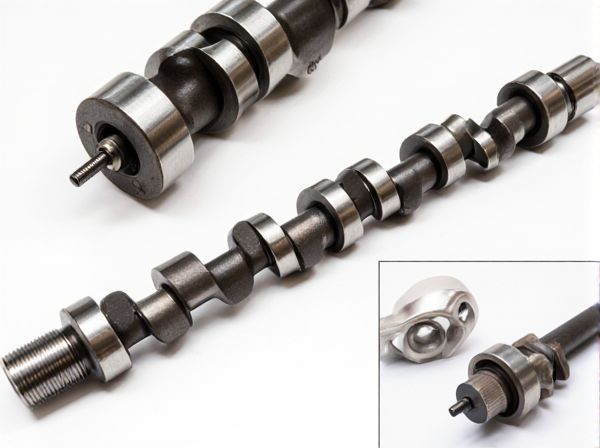
Photo illustration: Billet Crankshaft vs Forged Crankshaft
Billet crankshafts offer superior strength and precision, as they are machined from a solid piece of high-quality steel, making them ideal for high-performance engines. Forged crankshafts, created by compressing steel under high pressure, provide excellent durability and toughness at a more affordable cost, suitable for everyday use and moderate performance upgrades. You should choose based on your engine's power demands and budget, with billet crankshafts favored for extreme builds and forged ones for reliable, cost-effective performance.
Table of Comparison
| Feature | Billet Crankshaft | Forged Crankshaft |
|---|---|---|
| Material | Machined from a solid high-grade steel billet | Formed by heating and hammering steel |
| Strength | Superior tensile strength, ideal for high-performance engines | High strength but generally less than billet |
| Weight | Typically heavier due to dense steel | Lighter, allowing better engine response |
| Durability | Excellent fatigue resistance and longevity | Good durability, suitable for most applications |
| Customization | Highly customizable for specific engine builds | Limited customization, standard shapes |
| Cost | Higher price due to machining process | More affordable, mass-produced |
| Typical Use | Racing, high-horsepower engines, custom builds | Street performance, daily drivers, stock replacements |
Understanding Crankshaft Manufacturing Methods
Billet crankshafts are machined from a solid piece of high-grade steel, offering superior strength and precision compared to forged crankshafts, which are shaped by hammering heated metal billets into the desired form. The manufacturing process of billet crankshafts involves CNC machining, allowing for intricate designs and tighter tolerances that enhance engine performance and durability. Forged crankshafts, while more cost-effective and lighter, undergo a process that aligns metal grain for improved fatigue resistance but lack the customization options available with billet machining.
What Is a Billet Crankshaft?
A billet crankshaft is precision-machined from a solid piece of high-grade steel, offering superior strength and customization compared to forged crankshafts. It provides enhanced durability and performance, especially in high-stress applications like racing and high-performance engines. Unlike forged crankshafts, which are shaped by compressive forces, billet crankshafts allow for intricate designs and tighter dimensional tolerances.
What Is a Forged Crankshaft?
A forged crankshaft is manufactured by heating a solid steel billet and then shaping it under high pressure in a forging press, resulting in a dense, strong, and durable component ideal for high-performance engines. This process refines the grain structure, enhancing fatigue resistance and tensile strength compared to cast crankshafts. Forged crankshafts are commonly used in racing and heavy-duty applications due to their superior mechanical properties and reliability under extreme stress.
Key Differences: Billet vs Forged Crankshafts
Billet crankshafts are machined from a single block of high-grade steel, offering superior customization and precision compared to forged crankshafts, which are shaped by compressing heated metal. Forged crankshafts typically provide enhanced durability and fatigue resistance due to their grain structure alignment during forging, making them ideal for high-performance engines. The choice between billet and forged crankshafts depends on factors like required strength, manufacturing cost, and specific engine performance needs.
Strength and Durability Comparison
Billet crankshafts offer superior strength due to their manufacturing from a single piece of high-quality steel, resulting in enhanced resistance to fatigue and stress compared to forged crankshafts, which are formed by compressing steel billets under high pressure. Forged crankshafts provide excellent durability and toughness but may have slight internal grain inconsistencies that can affect long-term performance under extreme conditions. For applications requiring maximum strength and reliability, billet crankshafts are generally preferred, while forged versions balance cost and durability for most performance engines.
Performance Benefits: Billet vs Forged Crankshafts
Billet crankshafts offer superior customization and precision machining, resulting in enhanced balance and reduced vibration for high-performance engines, while forged crankshafts provide exceptional strength and durability due to their grain-flow structure. Billet crankshafts typically allow for lighter weight designs, improving engine responsiveness and high-RPM capability, whereas forged crankshafts excel in withstanding extreme stress and fatigue under heavy loads. Choosing between billet and forged crankshafts depends on the specific performance goals, with billet favored for bespoke, high-revving applications and forged preferred for robust, heavy-duty performance.
Cost Considerations for Each Type
Billet crankshafts typically cost more due to the extensive machining process from a solid steel block, offering superior strength and customization for high-performance engines. Forged crankshafts, produced by shaping heated steel billets under pressure, generally provide a more affordable option with excellent durability and toughness for most automotive applications. Budget-conscious buyers prioritize forged crankshafts for cost-efficient reliability, while performance-focused builders invest in billet crankshafts despite the higher upfront expense.
Applications: When to Choose Billet or Forged
Billet crankshafts offer superior customization and are ideal for high-performance racing engines requiring precise balance and strength under extreme conditions. Forged crankshafts provide excellent durability and cost-effectiveness, making them suitable for street vehicles, daily drivers, and moderate performance upgrades. Choosing billet is optimal for custom builds and maximum power output, while forged suits applications demanding reliability and longevity with budget considerations.
Pros and Cons: Billet Crankshafts
Billet crankshafts offer superior customization and strength due to being machined from a solid piece of high-grade steel, making them ideal for high-performance applications requiring precise specifications. Their manufacturing process allows for improved fatigue resistance and better balance, resulting in enhanced engine reliability and longevity. However, billet crankshafts tend to be significantly more expensive than forged options and typically require longer production times, which may not be suitable for budget-sensitive or quick-turn projects.
Pros and Cons: Forged Crankshafts
Forged crankshafts offer superior strength and durability due to the compression of metal grains during manufacturing, making them ideal for high-performance engines subject to extreme stress. They provide better resistance to fatigue and impact, reducing the risk of cracks or failure under heavy loads. However, forged crankshafts are generally heavier and more expensive to produce compared to billet crankshafts, which may limit their use in weight-sensitive applications.
 caratoz.com
caratoz.com